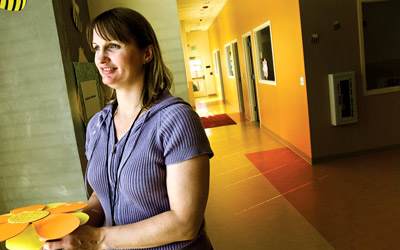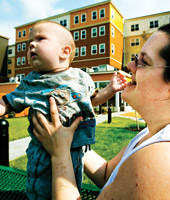Daily Miracles
“God protected me and my family when we were homeless. So I encourage our clients to rely on God, who will meet their needs.” Stacy Cleveland

“Hope” for shelter director
Stacy Cleveland is in the bright rooms and halls of Hope Place. The newly constructed shelter for homeless women and
their children is in a suburban setting, near light rail, and boasts a playground.
By Clint Kelly, Response Senior Writer [ckelly@spu.edu]
Photos by Mike Siegel
Stacy Patterson Cleveland looks every bit the young professional administrator that she is. It comes as little surprise that she oversees an annual budget north of a million dollars.
But few would guess that just 10 years
ago, this shelter director — with a staff of
25 and a live-in population of up to 150
at-risk women and children — was a cocaine and methamphetamine addict one step from ruin.
Raised in a loving Christian home, she had a passion for the outdoors and earned a bachelor’s degree in biology at Seattle Pacific University in 1997. But after a few years of living on her own, Cleveland drifted away from the church, entered into destructive relationships, and became a slave to her addictions. She lost her job and was close to eviction when she realized the next thing to go would be her children.
“I’d had enough loss in my life,” says Cleveland. “I called Seattle’s Union Gospel Mission (UGM) Women’s and Children’s Shelter, and they took us in.” Cleveland moved with her daughters,
then 7 and 5 months, from a drug dealer’s house into the shelter she runs today.
Not unlike the clients she serves,
she came for the treatment and stayed
for the unconditional love.
Hope in Crisis
At 5 a.m. every weekday, Cleveland answers to the alarm clock. Though the work ahead is physically and emotionally draining, she eagerly anticipates her day. Helping other women regain hope gives meaning to her past struggles — particularly now, when economic crisis is forcing more people than ever to seek shelter.
“I’m so grateful to have this job, a job I love,” she says. “Yet it comes with great responsibility. God protected me and my family when we were homeless. So I encourage our clients to be thankful for what they have right now, and to rely on God, who will meet their needs.”
At the best of times, the UGM Shelter’s clients are close to the financial edge. “It doesn’t take much to push them over,” explains Cleveland. “To have been through a great deal of trauma in your life and then to lose your job? It can be the last straw.”

Moms and their kids can work on a fresh start in the safe, supportive environment of the Women’s and Children’s Shelter. |
The economic downturn has meant an increase in demand for the Shelter’s services, with women and children the fastest growing segment of the homeless population in King County. It is estimated that on any given night in the city there are 3,000 homeless women and children in search of refuge.
Most of the women are single mothers. In addition to loss of income and domestic abuse, they come to shelters because of addiction, mental or physical health issues, and relocations from another city or state that go awry.
The bitter pill for Cleveland is that 24 out of every 25 women who need shelter are turned away for lack of space. That number dropped slightly in April when the UGM Shelter moved from its longtime location in a converted hotel in the International District to “Hope Place” in the NewHolly neighborhood — and nearly doubled its capacity.
Economic conditions, however, have dictated a hiring freeze for UGM, a no-fee nonprofit. So Cleveland and her staff must work even harder to care for the women who come to them for help.
The Next Right Thing
Cleveland starts work with 7 a.m. breakfast rounds, greeting each of the women and children in residence.
Then comes the reading of the overnight staff log for any concerns or crises that require follow-up. The shelter director checks in with her staff to see that new situations are properly handled.
At 9 a.m., two things happen. The entire household gathers for devotions and accountability sessions; and dozens of calls begin to pour in from more women hoping for a bed.
If a place for the night is all they want, callers are referred to other temporary emergency shelters. Those who make it into the UGM Women’s and Children’s Shelter program agree to regular Bible studies and personalized programs to break free from self-destructive behaviors (90 percent are addicted to alcohol and/or drugs). Women with substance abuse issues agree to a 12-month alcohol/drug recovery program and daily urinalysis and breathalyzer tests.
Not all stick it out. Most do.
Candy Bishop, once a daily crack cocaine user flirting with death, got her life back at the Shelter. “I walked in that door, and it was like going from pitch black to light. I remember that they gave me a bottle of pretty blue-green shampoo. I knew I didn’t deserve that shampoo; I was an addict, a freak.”
Also a mother, grandmother, and seasoned street fighter nicknamed Sugar Ray, Bishop was stunned at the acceptance she experienced at the Shelter. Sixteen months later and in recovery, she has passed one exam on the way to earning a GED, and is giddy with amazement. “Someone believed in me!”
“If Stacy can take off her mask, so can I,” says Bishop, who dreams of becoming a recovery counselor. “Do I worry about
the economy? I don’t ignore it, but my job
is to do the next right thing. God’s got tomorrow covered.”
Divine Intervention
The work day flies at Cleveland with breakneck speed. Focus meetings with residents who are struggling. Tours of Hope Place. Speaking engagements. Appointments with foundations that want to help fund the shelter. Networking with new volunteers. Classes in parenting, life skills, and foundational Christianity.
The director’s office space is populated by stuffed toys, games, Bibleman videos, and scads of family photos. House hum filters in from the hall: laughter, spirited talk, life getting done.

Weekly during 2008-–09, SPU sophomore Tanisha Hanson played with children at the shelter and worked with them on a Bible study activity. This fall, the pre-nursing major will lead the UGM volunteers from SPU. |
A proponent of “mandatory fun,” Cleveland teaches women and children how to enjoy life and make new, happy memories to pave over the old, ugly ones. “Our ladies are so traumatized they’ve forgotten how to have fun.”
And children, she says, bear the brunt of the poverty, violence, and substance abuse that drive their mothers onto the streets. The average homeless child loses two years of schooling and often arrives at the Shelter with escalated behavioral problems.
“We have to give the children the grace to figure out who they are,” explains Cleveland. One girl, who last Christmas received a gift from the shelter’s volunteer Santa, decided it wasn’t good enough. She threw a memorable fit.
“It was frustrating,” remembers the director. “Then at our morning community meeting shortly after, the kids were talking about the meaning of Christmas. This same girl spoke up and said it wasn’t about presents, but about Jesus. And she meant it. I have to remember that God is working behind the scenes all the time.”
Life Without Fear
By 4 p.m., Cleveland goes home to be with her own children: four daughters, ages 16, 10, 8, and 3. The eldest wants to study nursing at Seattle Pacific.
Husband Scott is assistant director of New Vision, UGM’s recovery program for men. Also a recovering addict, Scott met Stacy in a van on their way to a conference of gospel missions. Today, but for the occasional road trip to a national park, full-time jobs and raising a family fill every waking moment for the couple. They have no pets; keeping a plant alive is a challenge.
If she feels tired or discouraged, Stacy Cleveland reaches for her Bible. Isaiah 40:21–30 is a favorite, particularly the 29th verse: “He [the Lord] gives strength to the weary and increases the power of the weak.”
Happy memories include life with her parents, both SPU graduates, and the “amazing and godly” professors who taught her at Seattle Pacific. “We could explore the truth without being afraid,” she says.
At home and at work, Cleveland is known for living without fear. “I really admire how calm and collected Stacy stays,” says Diana Bunch, assistant director of the Shelter. “Her example helps us help our clients persevere until the right opportunity comes along. In these tough financial times, she personifies the absolute belief that we serve a God who is above economics.”
Helping Others and Giving Thanks
What motivates Cleveland to minister to women in this way are her own life experiences and Christ’s command to help those in need. “For many, crisis is only a paycheck or two away,” she says. “Although many of us are in difficult situations, there is always someone worse off. When I help others, I realize again how much I and my family have to be thankful for.”
The Union Gospel Mission is not your grandfather’s soup kitchen, says Cleveland. The Mission and its shelters are much more than a meal and a bed for a night; they exist to break the cycle of poverty, homelessness, abuse, and addiction — and to bear witness to the power of God to transform lives.
“More than the average person, our clients sense their need for the Lord,” says the shelter director. “Not a day goes by here that we don’t see miracles.”
Return to top
Back to Features Home
|